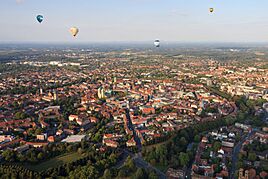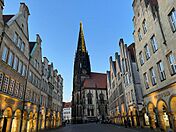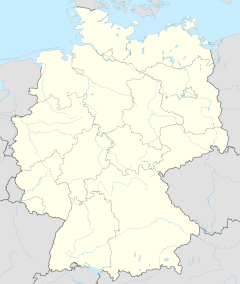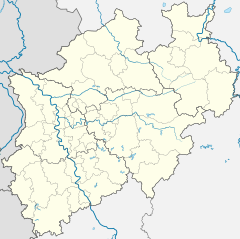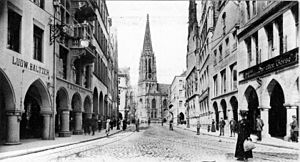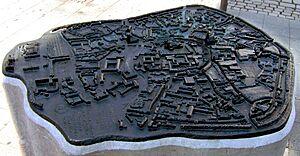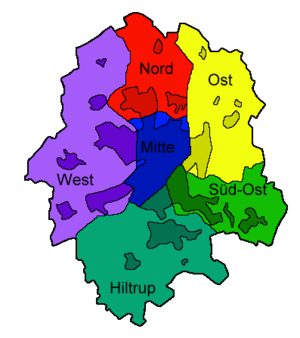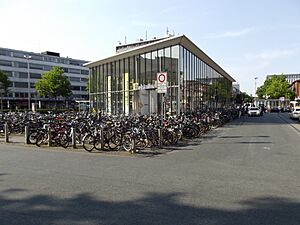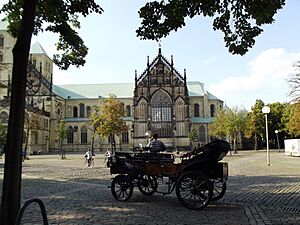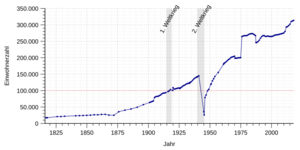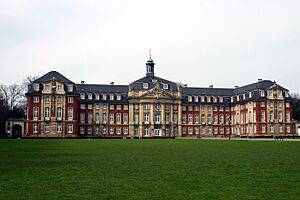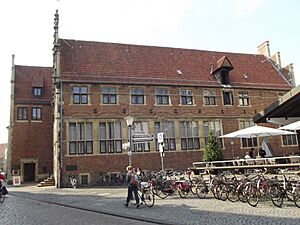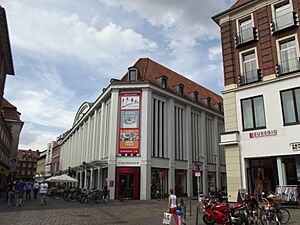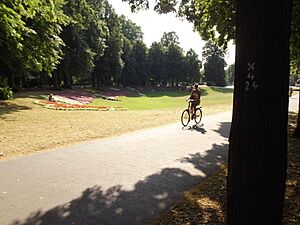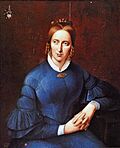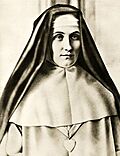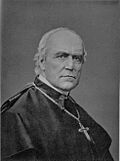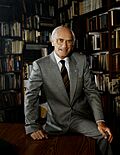Münster facts for kids
Quick facts for kids
Münster
Mönster (Westphalian)
|
|||
|---|---|---|---|
|
Aerial view of Münster
St Lambert's Church
Historical City Hall
Prinzipalmarkt
|
|||
|
|||
| Country | Germany | ||
| State | North Rhine-Westphalia | ||
| Admin. region | Münster | ||
| District | Urban district | ||
| Founded | 793 | ||
| Subdivisions | 6 | ||
| Area | |||
| • Total | 302.89 km2 (116.95 sq mi) | ||
| Elevation | 60 m (200 ft) | ||
| Population
(2022-12-31)
|
|||
| • Total | 320,946 | ||
| • Density | 1,059.612/km2 (2,744.38/sq mi) | ||
| Time zone | UTC+01:00 (CET) | ||
| • Summer (DST) | UTC+02:00 (CEST) | ||
| Postal codes |
48143–48167
|
||
| Dialling codes | 0251 02501 (Hiltrup, Amelsbüren) 02506 (Wolbeck, Angelmodde) 02533 (Nienberge) 02534 (Roxel) 02536 (Albachten) |
||
| Vehicle registration | MS | ||
| Website | www.muenster.de | ||
Münster is a city in North Rhine-Westphalia, Germany. It's in the northern part of the state and is known as the cultural heart of the Westphalia region. It's also a capital city for its local area.
Münster is famous for being the place where the Treaty of Westphalia was signed in 1648. This treaty officially ended the Thirty Years' War. Today, Münster is often called the "bicycle capital" of Germany because so many people ride bikes there!
The city became a "major city" (meaning it had over 100,000 people) in 1915. By 2014, about 300,000 people lived in Münster. A big part of its population is made up of students, with around 61,500 studying in the city.
Contents
History of Münster
Early Beginnings
Münster's story began in 793. A missionary named Ludger was sent by Charlemagne to spread Christianity in the area. In 797, Ludger started a school that later became the famous Cathedral School. This school is now known as Gymnasium Paulinum.
Ludger became the first bishop of Münster. The first main church, called a cathedral, was finished by 850. Because it was a place where roads and a river crossing met, and it had a market, church, library, and school, Münster quickly became an important center. In 1040, Heinrich III, a German king, was the first king to visit Münster.
Middle Ages and Major Events
During the Middle Ages, Münster was an important member of the Hanseatic League. This was a powerful group of trading cities in Northern Europe.
In 1534, a group called the Anababaptists took control of Münster during the Münster rebellion. They wanted to create a new kind of society. They claimed all property and burned most books, keeping only the Bible. They called the city "New Jerusalem." The Anabaptists were eventually defeated in 1535. Their leaders were captured and punished. As a warning, their bodies were displayed in metal baskets on the tower of St. Lambert's Church. You can still see these baskets today.
A very important event in Münster's history was the signing of the Peace of Westphalia in 1648. This treaty ended two major wars: the Thirty Years' War and the Eighty Years' War. It also made sure that the area around Münster would remain Roman Catholic.
From the 18th Century to World War II
The beautiful Schloss Münster (palace) was built between 1767 and 1787. It was designed by the famous architect Johann Conrad Schlaun. The University of Münster was founded in 1780. Today, it's a large and important university in Europe, with about 40,000 students.
In 1802, Münster was taken over by Prussia during the Napoleonic Wars. It later became the capital of the Prussian region of Westphalia. In 1899, the city's harbor opened, connecting Münster to the Dortmund-Ems Canal.
During the 1940s, Clemens August Graf von Galen, the Bishop of Münster, was a strong critic of the Nazi government. Because of his actions, Münster became a heavily guarded city during World War II. Many barracks (military buildings) were built there.
Münster was bombed heavily by Allied forces during the war, especially on October 25, 1944. About 63% of the city was destroyed, and 91% of the Old City was ruined. American and British forces fought their way into the city in April 1945, capturing it after house-to-house fighting.
After the War
After World War II, Münster's Old City was rebuilt to look like it did before the war. From 1946 to 1998, there was a Latvian secondary school in Münster. For many decades, British forces were stationed in the city, but the last ones left in 2013.
In 2004, Münster won an award for being one of the most livable cities in the world for its size. It's loved for being very bicycle-friendly and for its lively student atmosphere, thanks to its university.
Geography of Münster
Where is Münster?
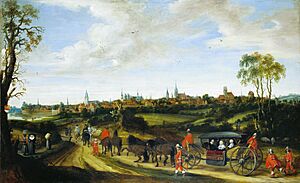
Münster is located on the Aa River. This is about 15 kilometers (9 miles) south of where the Aa joins the Ems River. The city is in a flat area called the "Westphalian Bight," which has many scattered farms.
The highest point in Münster is the Mühlenberg, which is 97 meters (318 feet) above sea level. The lowest point is near the Ems River, at 44 meters (144 feet) above sea level. The city center, at the Prinzipalmarkt, is 60 meters (197 feet) above sea level.
Nearby cities include Enschede in the Netherlands (about 65 km or 40 miles northwest), Osnabrück (about 44 km or 27 miles north), Dortmund (about 61 km or 38 miles south), and Bielefeld (about 62 km or 39 miles east).
Münster is one of Germany's largest cities by area. This is because it includes many rural areas that used to be separate towns before 1975. Almost half of the city's area is farmland.
City Layout
Münster's built-up area is quite spread out. You won't find many skyscrapers here. Instead, there are lots of detached houses and mansions. Even so, the city center is quite dense, with about 15,000 people per square kilometer.
The city covers about 303 square kilometers (117 square miles). A large part of this is used for farming and recreation (156.61 km²). Forests cover 56.69 km², and water covers 8.91 km². The city's edge is 107 kilometers (66 miles) long. From north to south, the city stretches 24.4 km (15.2 miles), and from east to west, it's 20.6 km (12.8 miles).
Climate in Münster
People in Münster sometimes joke, "Either it rains or the church bells ring. And if both happen, it's Sunday!" However, the amount of rain Münster gets each year (about 758 mm or 30 inches) is actually close to the average for Germany. It just feels like it rains a lot because there are many rainy days with small amounts of rain.
The average temperature in Münster is 9.4°C (48.9°F). The city gets about 1500 hours of sunshine per year, which is less than many other German cities. Winters are usually mild, and heavy snowfall is rare. Summers have average temperatures for Germany.
On July 28, 2014, Münster experienced record rainfall. One weather station reported 122.2 liters per square meter, and another recorded 292 liters per square meter in just seven hours! This caused major flooding throughout the city.
| Climate data for Münster (Münster Osnabrück Airport) (1991–2020 normals) | |||||||||||||
|---|---|---|---|---|---|---|---|---|---|---|---|---|---|
| Month | Jan | Feb | Mar | Apr | May | Jun | Jul | Aug | Sep | Oct | Nov | Dec | Year |
| Mean daily maximum °C (°F) | 5.2 (41.4) |
6.2 (43.2) |
10.1 (50.2) |
15.0 (59.0) |
18.9 (66.0) |
21.8 (71.2) |
24.2 (75.6) |
23.7 (74.7) |
19.5 (67.1) |
14.5 (58.1) |
9.1 (48.4) |
5.8 (42.4) |
14.5 (58.1) |
| Daily mean °C (°F) | 2.7 (36.9) |
3.1 (37.6) |
5.9 (42.6) |
9.9 (49.8) |
13.7 (56.7) |
16.6 (61.9) |
18.7 (65.7) |
18.3 (64.9) |
14.5 (58.1) |
10.4 (50.7) |
6.3 (43.3) |
3.5 (38.3) |
10.3 (50.5) |
| Mean daily minimum °C (°F) | 0.0 (32.0) |
0.0 (32.0) |
1.9 (35.4) |
4.6 (40.3) |
8.2 (46.8) |
11.2 (52.2) |
13.4 (56.1) |
13.0 (55.4) |
9.9 (49.8) |
6.6 (43.9) |
3.3 (37.9) |
0.9 (33.6) |
6.1 (43.0) |
| Average precipitation mm (inches) | 64.5 (2.54) |
49.2 (1.94) |
49.6 (1.95) |
40.5 (1.59) |
54.8 (2.16) |
63.4 (2.50) |
73.9 (2.91) |
78.5 (3.09) |
68.7 (2.70) |
63.1 (2.48) |
61.5 (2.42) |
67.8 (2.67) |
735.7 (28.96) |
| Average precipitation days (≥ 1.0 mm) | 17.6 | 15.8 | 15.4 | 13.5 | 13.7 | 14.9 | 15.2 | 15.2 | 14.3 | 15.6 | 17.8 | 19.1 | 188.1 |
| Average snowy days (≥ 1.0 cm) | 4.6 | 3.6 | 1 | 0 | 0 | 0 | 0 | 0 | 0 | 0 | 0.5 | 3.3 | 13 |
| Average relative humidity (%) | 85.5 | 82.2 | 76.9 | 69.8 | 69.3 | 71.1 | 71.0 | 73.2 | 79.6 | 83.8 | 87.1 | 87.3 | 78.1 |
| Mean monthly sunshine hours | 51.6 | 73.3 | 124.2 | 178.4 | 206.7 | 203.2 | 212.3 | 193.3 | 148.2 | 108.8 | 57.1 | 44.2 | 1,597.6 |
| Source: World Meteorological Organization | |||||||||||||
Neighboring Areas
Münster shares borders with several other cities and towns. These include Altenberge, Greven, Telgte, Everswinkel, Sendenhorst, Drensteinfurt, Ascheberg, Senden, and Havixbeck.
City Districts
Münster is divided into six main administrative districts. These are "Mitte" (Middle), "Nord" (North), "Ost" (East), "West", "Süd-Ost" (South-East), and "Hiltrup". Each district has its own council of 19 elected representatives.
The districts are also divided into smaller areas. While there are official terms, people usually just use the names of the communities that were joined together to form the city.
Here are the main districts and some of their areas:
- Mitte:
- Kernbereich (Centre)
- Nord:
- Münster-Coerde|Coerde
- Kinderhaus
- Sprakel with Sandrup
- Ost:
- Dyckburg, including Mariendorf and Sudmühle
- Gelmer with Gittrup
- Handorf with Kasewinkel, Kreuzbach, Laer, Dorbaum and Verth
- Mauritz-Ost and Mondstraße, also known as St. Mauritz
- West:
- Albachten
- Gievenbeck
- Mecklenbeck
- Nienberge with Häger, Schönebeck and Uhlenbrock
- Roxel with Altenroxel and Oberort
- Sentruper Höhe
- Süd-Ost:
- Angelmodde with Hofkamp
- Gremmendorf with Loddenheide
- Wolbeck
- Hiltrup:
- Amelsbüren with Sudhoff, Loevelingloh and Wilbrenning
- Berg Fidel
- Hiltrup
The city center itself has many smaller, historic neighborhoods like Aaseestadt, Erphoviertel, and Kreuzviertel.
Population of Münster
Münster has a population of about 320,000 people. It is one of the largest cities in North Rhine-Westphalia and among the top 20 largest in Germany. It's also the seventh largest German city by area.
Münster is considered one of Germany's oldest cities, being a major city since around 1000 AD. It reached 100,000 residents in 1948. The population has continued to grow since the 1980s, largely because of its popular university. As mentioned, Münster is also known for its bicycles, with some people saying there are more bikes than people! The city reached 300,000 residents in 2014.
Here are the largest foreign groups living in Münster by nationality (as of December 31, 2022):
| Rank | Nationality | Population |
|---|---|---|
| 1 | 3,478 | |
| 2 | 2,365 | |
| 3 | 1,885 | |
| 4 | 1,735 | |
| 5 | 1,636 | |
| 6 | 1,343 | |
| 7 | 1,105 | |
| 8 | 987 | |
| 9 | 865 | |
| 10 | 738 |
Münster's Economy
Münster is home to many different types of businesses. These include government offices, consulting firms, insurance companies, banks, and publishing houses. The service industry, which provides help and support to people and businesses, has created many jobs.
The city has a good job market. Most of the people who work in Münster (over 80%) are in the service sector. About 17% work in manufacturing and construction, and a small number (1%) work in farming.
Main Sights to See
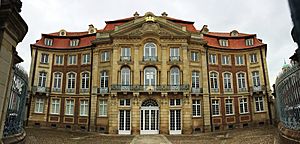
Münster has many interesting places to visit:
- St. Paul's Cathedral: Built in the 13th century, this large church was fully restored after World War II. It has an amazing astronomical clock from 1540 that shows the planets' movements and plays a tune every noon.
- The Prinzipalmarkt: This is the main shopping street in the city center. Here you'll find the Gothic city hall from the 14th century. This is where the Peace of Westphalia treaty was signed in 1648, ending the Thirty Years' War.
- St Lambert's Church: Built in 1375, this church has three metal cages hanging from its tower. These cages were used in 1535 to display the bodies of the Anabaptist leaders after the rebellion.
- Überwasserkirche: A Gothic church from 1340 that was once part of a religious foundation that grew into the University of Münster.
- The Schloss (palace): This beautiful palace was built between 1767 and 1787. It was once the home of the prince-bishops and is now the main administrative building for the University of Münster.
- The Botanischer Garten Münster: A lovely botanical garden that was started in 1803.
- The Zwinger fortress: Built in 1528, this fortress was used as a prison for many years. During World War II, it was also used to hold prisoners.
- "Krameramtshaus" (1589): An old guild house where the Dutch delegation stayed during the signing of the Peace of Westphalia.
- Erbdrostenhof (1749–53): A Baroque palace also built by Schlaun. It was the birthplace of Blessed Mary of the Divine Heart.
- Clemenskirche (1745–53): Another beautiful Baroque church designed by Schlaun.
- City Museum ("Stadtmuseum"): This museum shows the political and cultural history of Münster from its beginnings to today.
- Pablo Picasso Museum of Graphic Art: This is the only museum dedicated only to the graphic artworks of Pablo Picasso.
- Pinkus Müller: The only brewery left in Münster. There used to be over 150!
- Kiepenkerl Statue: A famous statue in Kiepenkerl Square.
Education in Münster
Münster is a big center for education. It has many colleges and universities, including the famous University of Münster and the University of Applied Sciences. The city also has 92 primary and secondary schools. In 2015/16, there were 61,441 students in Münster.
Transportation
By Air
Münster Osnabrück Airport serves Münster. It offers flights to many European cities.
By Bicycle
Münster is known as the bicycle capital of Germany! In 2007, more people traveled by bicycle (37.6%) than by car (36.4%). The city has a huge network of bike paths, including the popular "Promenade" that goes all around the city center. Cars are not allowed on the Promenade, but pedestrians can use it. There are also special traffic lights just for bikes. You can even rent bikes at special stations in Münster.
By Train
Münster's Central Station is a major train hub. You can take Intercity trains from Münster to many other big cities across Germany.
Public Transport
Münster used to have a tram system, but it closed in 1954. Today, the city has public buses, including express buses and sightseeing buses. You can also find "waterbuses" and Lime scooters for rent. Münster is the largest German city that does not have an underground train (U-Bahn) or a suburban train (S-Bahn) system.
Sports
Münster is home to Preußen Münster, a sports club founded in 1906. Their main sport is football, and the team plays at Preußenstadion. Another important sports team is the USC Münster e.V. volleyball club.
Uni Baskets Münster is the city's professional basketball team. They play their home games at Sporthalle Berg Fidel.
Twin Towns and Sister Cities
Münster is connected with other cities around the world through "twinning" or "sister city" programs. These partnerships help promote cultural exchange and friendship.
 York, England, United Kingdom (1958)
York, England, United Kingdom (1958) Orléans, France (1960)
Orléans, France (1960) Kristiansand, Norway (1967)
Kristiansand, Norway (1967) Monastir, Tunisia (1969)
Monastir, Tunisia (1969) Rishon LeZion, Israel (1981)
Rishon LeZion, Israel (1981) Fresno, United States (1986)
Fresno, United States (1986) Ryazan, Russia (1989)
Ryazan, Russia (1989) Mühlhausen, Germany (1990)
Mühlhausen, Germany (1990) Lublin, Poland (1991)
Lublin, Poland (1991) Enschede, Netherlands (2020)
Enschede, Netherlands (2020)
Notable People from Münster
Many famous people have come from Münster, including:
- Annette von Droste-Hülshoff (1797–1848), a famous noble and poet.
- Wilhelm Emmanuel von Ketteler (1811–1877), a theologian and politician who became a bishop.
- Mary of the Divine Heart Droste zu Vischering (1863–1899), a noble and nun.
- Clemens August Graf von Galen (1878–1946), a cardinal and Bishop of Münster, known for speaking out against the Nazis.
- Moondog (1916–1999), a unique musician and composer.
- Franka Potente (born 1974), a German actress.
- Götz Alsmann (born 1957), a television presenter and musician.
- Ute Lemper (born 1963), a cabaret singer and actress.
- Günther Jauch (born 1965), a popular TV presenter.
Images for kids
See also
 In Spanish: Münster para niños
In Spanish: Münster para niños


